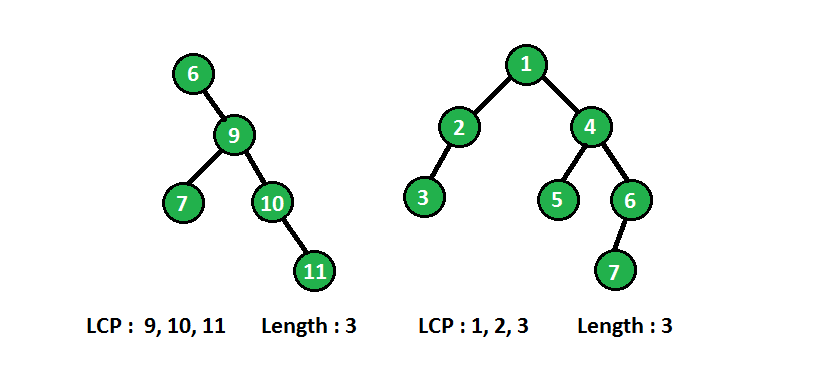给定一棵二叉树,找到最长路径的长度,该路径包括具有递增顺序的连续值的节点。每个节点都被视为长度为1的路径。
例子:
下图显示了具有最长连续路径(LCP)的二叉树: 
我们可以递归地解决上述问题。在每个节点上,我们都需要其父节点的信息,如果当前节点的值比其父节点大,那么它会生成一条连续路径,在每个节点上,我们将节点的值与其父值进行比较,并相应地更新最长的连续路径。
为了获取父节点的值,我们将(node_value + 1)作为参数传递给递归方法,并将节点值与此参数值进行比较,如果满足,请更新连续路径的当前长度,否则通过1。
请参阅下面的代码,以更好地理解:
C++
// C/C++ program to find longest consecutive
// sequence in binary tree
#include
using namespace std;
/* A binary tree node has data, pointer to left
child and a pointer to right child */
struct Node
{
int data;
Node *left, *right;
};
// A utility function to create a node
Node* newNode(int data)
{
Node* temp = new Node;
temp->data = data;
temp->left = temp->right = NULL;
return temp;
}
// Utility method to return length of longest
// consecutive sequence of tree
void longestConsecutiveUtil(Node* root, int curLength,
int expected, int& res)
{
if (root == NULL)
return;
// if root data has one more than its parent
// then increase current length
if (root->data == expected)
curLength++;
else
curLength = 1;
// update the maximum by current length
res = max(res, curLength);
// recursively call left and right subtree with
// expected value 1 more than root data
longestConsecutiveUtil(root->left, curLength,
root->data + 1, res);
longestConsecutiveUtil(root->right, curLength,
root->data + 1, res);
}
// method returns length of longest consecutive
// sequence rooted at node root
int longestConsecutive(Node* root)
{
if (root == NULL)
return 0;
int res = 0;
// call utility method with current length 0
longestConsecutiveUtil(root, 0, root->data, res);
return res;
}
// Driver code to test above methods
int main()
{
Node* root = newNode(6);
root->right = newNode(9);
root->right->left = newNode(7);
root->right->right = newNode(10);
root->right->right->right = newNode(11);
printf("%d\n", longestConsecutive(root));
return 0;
} Java
// Java program to find longest consecutive
// sequence in binary tree
class Node
{
int data;
Node left, right;
Node(int item)
{
data = item;
left = right = null;
}
}
class Result
{
int res = 0;
}
class BinaryTree
{
Node root;
// method returns length of longest consecutive
// sequence rooted at node root
int longestConsecutive(Node root)
{
if (root == null)
return 0;
Result res = new Result();
// call utility method with current length 0
longestConsecutiveUtil(root, 0, root.data, res);
return res.res;
}
// Utility method to return length of longest
// consecutive sequence of tree
private void longestConsecutiveUtil(Node root, int curlength,
int expected, Result res)
{
if (root == null)
return;
// if root data has one more than its parent
// then increase current length
if (root.data == expected)
curlength++;
else
curlength = 1;
// update the maximum by current length
res.res = Math.max(res.res, curlength);
// recursively call left and right subtree with
// expected value 1 more than root data
longestConsecutiveUtil(root.left, curlength, root.data + 1, res);
longestConsecutiveUtil(root.right, curlength, root.data + 1, res);
}
// Driver code
public static void main(String args[])
{
BinaryTree tree = new BinaryTree();
tree.root = new Node(6);
tree.root.right = new Node(9);
tree.root.right.left = new Node(7);
tree.root.right.right = new Node(10);
tree.root.right.right.right = new Node(11);
System.out.println(tree.longestConsecutive(tree.root));
}
}
// This code is contributed by shubham96301Python3
# Python3 program to find longest consecutive
# sequence in binary tree
# A utility class to create a node
class newNode:
def __init__(self, data):
self.data = data
self.left = self.right = None
# Utility method to return length of
# longest consecutive sequence of tree
def longestConsecutiveUtil(root, curLength,
expected, res):
if (root == None):
return
# if root data has one more than its
# parent then increase current length
if (root.data == expected):
curLength += 1
else:
curLength = 1
# update the maximum by current length
res[0] = max(res[0], curLength)
# recursively call left and right subtree
# with expected value 1 more than root data
longestConsecutiveUtil(root.left, curLength,
root.data + 1, res)
longestConsecutiveUtil(root.right, curLength,
root.data + 1, res)
# method returns length of longest consecutive
# sequence rooted at node root
def longestConsecutive(root):
if (root == None):
return 0
res = [0]
# call utility method with current length 0
longestConsecutiveUtil(root, 0, root.data, res)
return res[0]
# Driver Code
if __name__ == '__main__':
root = newNode(6)
root.right = newNode(9)
root.right.left = newNode(7)
root.right.right = newNode(10)
root.right.right.right = newNode(11)
print(longestConsecutive(root))
# This code is contributed by PranchalKC#
// C# program to find longest consecutive
// sequence in binary tree
using System;
class Node
{
public int data;
public Node left, right;
public Node(int item)
{
data = item;
left = right = null;
}
}
class Result
{
public int res = 0;
}
class GFG
{
Node root;
// method returns length of longest consecutive
// sequence rooted at node root
int longestConsecutive(Node root)
{
if (root == null)
return 0;
Result res = new Result();
// call utility method with current length 0
longestConsecutiveUtil(root, 0, root.data, res);
return res.res;
}
// Utility method to return length of longest
// consecutive sequence of tree
private void longestConsecutiveUtil(Node root, int curlength,
int expected, Result res)
{
if (root == null)
return;
// if root data has one more than its parent
// then increase current length
if (root.data == expected)
curlength++;
else
curlength = 1;
// update the maximum by current length
res.res = Math.Max(res.res, curlength);
// recursively call left and right subtree with
// expected value 1 more than root data
longestConsecutiveUtil(root.left, curlength,
root.data + 1, res);
longestConsecutiveUtil(root.right, curlength,
root.data + 1, res);
}
// Driver code
public static void Main(String []args)
{
GFG tree = new GFG();
tree.root = new Node(6);
tree.root.right = new Node(9);
tree.root.right.left = new Node(7);
tree.root.right.right = new Node(10);
tree.root.right.right.right = new Node(11);
Console.WriteLine(tree.longestConsecutive(tree.root));
}
}
// This code is contributed by 29AjayKumar输出:
3
在下面的链接中也进行了讨论:
二叉树中最大连续增加路径长度